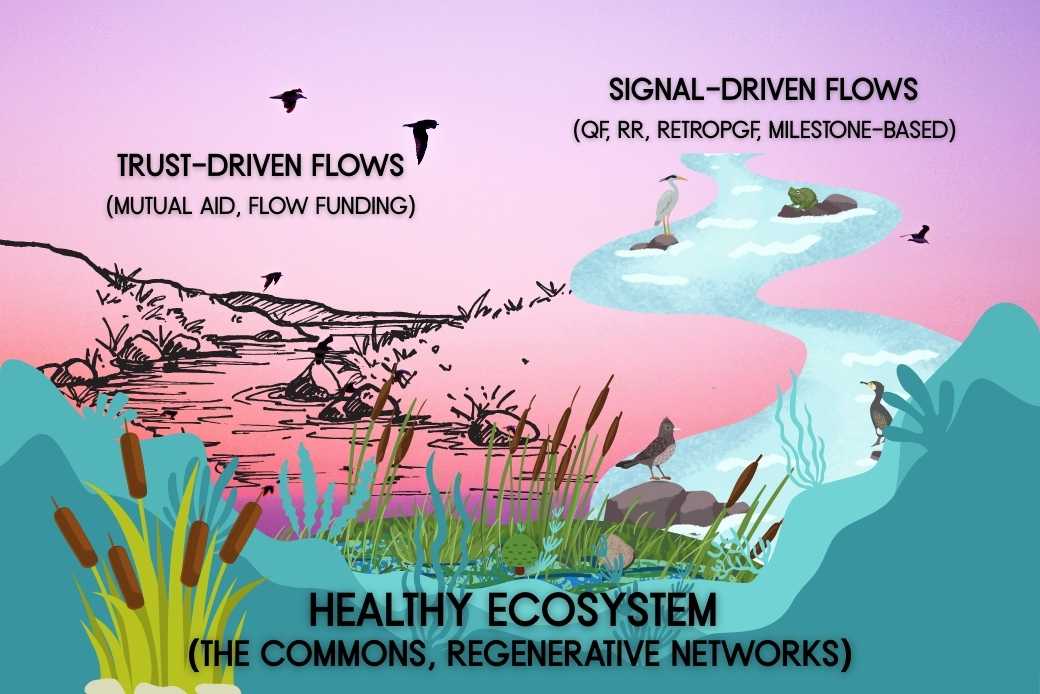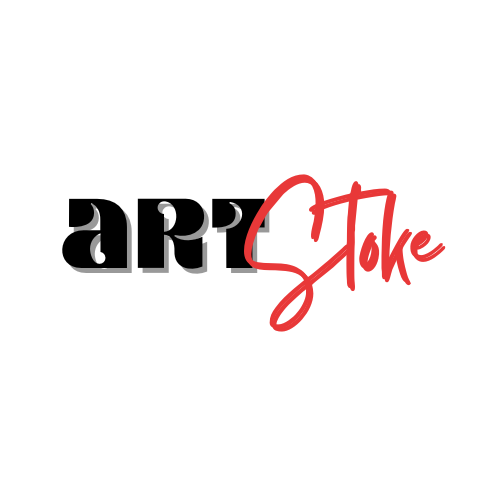In decentralised systems, funding doesn’t flow to ideas in isolation — it flows through relationships, recognition and resonance. To unlock support through decentralised funding models like Quadratic Funding (QF), Reputational Funding and Retroactive Public Goods Funding, you need more than a great proposal. You need an ecosystem.
Understanding your ecosystem — who’s doing what, where trust flows, and how your work fits in — is foundational to accessing funding using decentralised frameworks.

An ecosystem is a living, interdependent system of actors (people, organisations, technologies, values, resources) that collectively support a shared purpose or field of transformation (systems change, social impact, ecological impact). – Key Concepts: A Living Glossary for the Commons
Why Ecosystem Awareness Matters
In decentralised ecosystems, traditional gatekeepers are replaced by peer networks and community signals. These systems reward not just what you’re building, but how you’re building it, who you’re building it with, and how others experience your impact.
Your visibility, trust and participation in a living network often matter more than output alone. In this space, impact is relational — it happens between people.
Decentralised Funding Models that Centre Ecosystem and Relational Intelligence
1. Quadratic Funding (QF): Funding by the Many, Not the Few
Quadratic Funding allows many small donations (micro-contributions) to have more influence than a few large ones. A matching pool algorithmically amplifies the projects that receive broad community support, not just deep-pocketed backing.
Why ecosystem matters
- QF rewards projects that are visible, trusted and valued by the community.
- If people don’t know you — or don’t feel aligned — they won’t co-signal with their support.
- You can’t fake resonance. QF surfaces authentic relationships.
Best for builders, project creators, tool developers, public goods innovators with early-stage traction and community alignment.
Strategy Tip:
To succeed in QF rounds, be visible before the campaign. Show up in forums, DAOs, Telegrams. Build trust over time — not just when you need funds.
2. Reputational Funding (RR): Recognition is the Reward
Reputational Funding tools (like Coordinape and Hypercerts) reward people based on perceived impact and peer acknowledgment, rather than deliverables. It’s a trust economy.
Why ecosystem matters
- Your funding depends on how others experience your work.
- You’re rewarded when people feel you’re contributing meaningfully — especially when your work is relational, cultural, or regenerative.
- This can’t be tracked through spreadsheets — it’s felt and communicated through shared experience.
Best for community stewards, cultural weavers, connectors, facilitators, educators — those whose work is hard to quantify but deeply felt.
Strategy Tip:
Build in public. Co-create. Give credit. The more people feel part of your journey, the more they’re inclined to uplift you.
3. Retroactive Public Goods Funding (RetroPGF): Rewarding Proven Impact
RetroPGF (used by Optimism and similar protocols) doesn’t fund ideas or promises. It rewards impact that has already happened — tangible work that has created value for the ecosystem.
But here’s the catch: RetroPGF is a network effect in disguise.
And this is why ecosystem matters
While it appears to reward individuals for their past (or “successful”) contributions, the reality is that funding decisions often depend on how widely your impact has been seen, acknowledged and built upon by others.
- Your work carries more weight when others reference it, use it, or mention you in their own applications and updates.
- In many cases, being part of the ecosystem’s shared story — mentioned on social media, cited in forums, linked in documentation — is what gets you noticed.
- The more your contributions ripple through your network, the stronger your case for RetroPGF funding becomes.
Best for core contributors, open-source developers, creative experiments, or advocacy work that’s proven with visible ecosystem value.
Strategy Tip:
Contribute early and often. Collaborate visibly. Let your work speak through the voices of your community. RetroPGF isn’t just about visibility — it’s about networked resonance.

4. Mutual Aid / Informal Trust-Based Funding: Funding as Reciprocity, Not Transaction
Often overlooked in the “tech-heavy” funding space, mutual aid networks are decentralised by nature and deeply ecosystem-dependent. They operate on trust, reciprocity and shared values — not formal metrics or pitch decks.
Think Stokvels, value-aligned DAOs, or informal peer circles that share resources based on lived relationships.
Why ecosystem matters
- Funding flows through social bonds, not applications.
- Your value is remembered, not pitched.
- It’s not transactional, but it is relationally accountable.
Best for artists, healers, journalists, writers, local organisers, caregivers and those embedded in tight-knit, values-driven and values-aligned communities and trust circles.
Strategy Tip:
Offer something before asking. Show up consistently. Stay present in the circle, and track contributions through mutual memory and care.
5. Milestone-Based or Streaming Grants (Coordinated DAOs): Progress in Motion, Funded in Flow
Some DAOs use milestone-based funding where contributors are paid as collaborative goals are reached. These models emphasize shared progress and collective delivery. Milestone-based funding is common in guilds, contributor collectives and ecosystem-wide working groups.
Payment is often streamed (e.g. via Superfluid), encouraging ongoing engagement and mutual responsibility. Streaming Grants give contributors steady, fair, flexible funding while work is happening, not just after milestone is reached. Even if the payment streams continuously, the eligibility for starting or continuing that stream is based on visible performance, collective agreement, or proofs of work.
Why ecosystem matters
- Progress depends on coordination and trust between all involved.
- Milestones are set and evaluated collectively, not imposed from above.
Best for cross-functional teams, DAO teams/contributors, co-builders of infrastructure, protocols, and creative platforms working toward shared delivery.
Strategy Tip:
Be active in DAO working groups. Clarify roles, co-design milestones and goals, and participate in peer assessment. Your influence grows with your embeddedness.
6. Flow Funding: Trust in Motion
Flow Funding is a decentralised, trust-based funding model where participants are given small pools of capital and empowered to flow those funds onward to others they trust and recognise as creating meaningful value.
Instead of applying for funding through fixed criteria, participants become funders themselves, moving resources organically through networks of lived relationship and ecosystem awareness.
Why ecosystem matters
- Flow Funding depends on deep relational intelligence — you must know your ecosystem well enough to recognise where trust, momentum and emerging need exist.
- It strengthens community ties by making trust visible and actionable.
- It honours the idea that those closest to the work are best positioned to see who is doing meaningful, needed work.
Best for tight-knit creative communities, regenerative commons projects, emergent collectives, and trust-based micro-networks that need flexibility rather than bureaucracy.
Strategy Tip:
Anchor yourself in the ecosystem through presence, contribution, and visible trustworthiness. In Flow Funding, being “known and trusted” is your grant application.
The Distinction between Signal-Driven vs Trust-Driven Funding

While trust underpins all healthy decentralised systems, signal-driven funding asks: “What visible value or progress has been demonstrated?” Trust-driven funding asks: “Who do we know and trust to steward resources wisely?”
Signal-Driven Funding
These models reward public signals of value — contributions are measured, amplified, or recognised by the wider network. Funding flows where resonance and visibility are strongest.
Trust-Driven Funding
These models flow through private trust relationships — funds are moved through direct recognition, relational credibility, and proximity. Funding flows where lived trust and care are strongest.
Both are essential to healthy decentralised ecosystems.
Signal-driven funding scales collective attention; trust-driven funding deepens local resilience.
Healthy systems need both: wide networks of signal and deep wells of trust.
| Type | Models | Key Mechanism |
|---|---|---|
| Signal-Driven | Quadratic Funding, Reputational Funding, RetroPGF, Milestone/Streaming Grants | Funding flows based on visible, externally validated contribution or alignment |
| Trust-Driven | Mutual Aid, Flow Funding | Funding flows based on direct relational trust and personal network judgment |
Signal & Trust: Summary of the Six
When designing or participating in decentralised funding ecosystems, it’s not enough to “chase funding.” Understanding how trust and signal move through your network allows you to build authentic relationships, contribute visibly, and invite support in ways that regenerate the system — not just extract from it.
Quadratic Funding – Community-aligned signal amplification. Funding that amplifies broad, grassroots support, rewarding projects that many people value, not just a few large donors.
Reputational Funding – Peer recognition and relational credibility. Funding based on peer acknowledgment of meaningful contributions, not just output metrics.
Retroactive Public Goods Funding (RetroPGF) — Visible, networked impact. Rewards contributors after impact has been demonstrated and recognised across the ecosystem i.e. not for ideas, but for lived contribution.
Mutual Aid / Informal Trust-Based Funding — Tight-knit, value-driven reciprocity. Funding that flows through deep relational trust and shared values, within close or values-aligned communities.
Flow Funding — Trust-in-motion, peer-to-peer resource stewardship. Participants receive funds and are trusted to reflow them onward to others based on relational knowledge and emerging needs — funding becomes a living river, not a fixed pipeline.
Milestone-Based / Streaming Funding — Signal-verified, real-time collaboration. Funding that flows incrementally as contributors demonstrate progress toward shared goals. Instead of a lump sum, resources are streamed over time and adjusted dynamically based on visible achievement and collective agreement.
Final Thought: You’re Not Just Building a Project — You’re Growing Roots
In decentralised funding, your ecosystem is your infrastructure. It’s where meaning is made, trust is built, support is co-created and funding flows. So don’t just create in isolation or focus on outputs. Situate your purpose within a living system. Map your allies, show up in community and co-create the future. Because in the commons, money follows meaning — and meaning flows through human connection.





